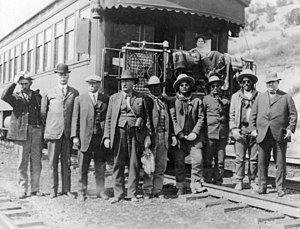Bluff War
| Bluff War | |||||||
|---|---|---|---|---|---|---|---|
| Part of the Ute Wars, Navajo Wars | |||||||
 Prisoners of the Bluff War in Thompson, Utah, waiting to board a train for their trial in Salt Lake City. Photo includes Marshal Nebeker, carrying the binoculars, and General Scott, third from left. Chief Polk is standing in between Nebeker and Jess Posey, while Chief Posey stands to the right of Jess, next to Tse-ne-gat. |
|||||||
|
|||||||
| Belligerents | |||||||
|
|
Ute Paiute |
||||||
| Commanders and leaders | |||||||
|
|
Polk Posey |
||||||
| Casualties and losses | |||||||
| ~2 killed ~5 wounded |
1 killed 2 wounded ~160 captured |
||||||
| Civilian Casualties 2 killed | |||||||
The Bluff War, also known as Posey War of 1915, or the Polk and Posse War, was one of the last armed conflicts between the United States and native Americans. It began in March 1914 and was the result of an incident between a Utah shepherd and Tse-ne-gat, the son of the Paiute Chief Narraguinnep ("Polk"). It was notable for involving Chief Posey and his band of renegades who helped Polk fight a small guerrilla war against local Mormon settlers and Navajo policemen. The conflict centered on the town of Bluff, Utah and ended in March 1915 when Polk and Posey surrendered to the United States Army.
Chief Posey played a prominent role in the war, as it was primarily his band who took up arms. Between 1881 and 1923, Posey led his braves in several skirmishes against the Navajo and the American settlers, killing several, including several at the "Pinhook Massacre" on the northwest slopes of the La Sal Mountains. His band, which included about 100 people, both Ute and Paiute, was feared and well-known. Unlike most native American tribes, Polk's and Posey's followers did not reside on a reservation, but rather they lived near Bluff, around Allen and Montezuma Canyons. Ultimately, Posey's struggle to keep Westward expansion away failed in 1905, when the town of Blanding, then known as Grayson, was founded in the center of the Ute's last prominent hunting grounds. For the next ten years, sporadic fighting occurred, until March 1914 when Tse-ne-gat, the son of Chief Polk, allegedly robbed and murdered an ethnic Mexican shepherd named Juan Chacon on the Ute Mountain Reservation in Colorado. Chacon had camped with a group of Utes and Paiutes from Polk's band, among them Tse-ne-gat, also known as Everett Hatch. A few days later Chacon was found dead and witnesses claimed that Tse-ne-gat was responsible. Chief Polk defended his son's actions, so when Navajo policemen attempted to arrest Tse-ne-gat, Polk drove them off with rifle fire. For the next six months, newspapers around the United States circulated reports of the incident. By that time, Polk had taken his band, about eighty-five people, to the Navajo Mountain area. Chief Posey and his warriors joined them, setting the stage for a battle. Local newspapers reported that "Hatch [Tse-ne-gat] has a notorious reputation as a bad man" and that his group was "terrorizing" the settlers in the Bluff area, they also said that Tsa-na-gat was "strongly entrenched with fifty braves who will stand by him to the last man."
...
Wikipedia
